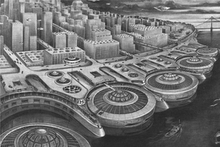William Kentridge makes my heart hurt, in a good way and was the first artist to inspire my crusty old tearducts to produce.
Still from Weighing.... and Wanting (I believe.)
 Somehow this is the saddest and sweetest question anyone has ever asked.
Somehow this is the saddest and sweetest question anyone has ever asked.
A lot of quality is lost in these youtube bootlegs but I still love them.
I'm not sure of the titleStill from Weighing.... and Wanting (I believe.)
 Somehow this is the saddest and sweetest question anyone has ever asked.
Somehow this is the saddest and sweetest question anyone has ever asked.Stills from Felix in Exile:
 This text is stolen but says everything better than I could... because I am lazy.
This text is stolen but says everything better than I could... because I am lazy.
Felix in Exile was created in 1994, amidst ongoing public debates on the relationship between the country’s division of ownership and the formation of identity which accompanied the first open elections in South Africa. The film tells the stories of Felix, a man living in exile in Paris, and of Nandi, a woman working as a land surveyor. The woman is Felix’s alter ego. She stands for the longing for one’s homeland, and how for his sake someone bears witness to the incidents in the new, democratic South Africa. No differently than with the fears and memories that flood over him in his room, the world ultimately overpowers Nandi as well—she is shot.
Her many gazes are found in the mirror. The drawings Felix produce flood his sparse room like water, like memory and longing. On the other hand, Nandi is embedded in a cosmic distance that dissipates in the misery of black South Africa. In the topography of the landscape, Nandi’s surveying instruments search for traces of history, for a standard of existence, for a direction.
The drawings and images of Felix and Nandi pile up one atop the other, functioning in both cases as seismographic documents of an emotional shock. The victims of the story are discovered on discarded daily newspapers and written as such into the landscape. Nandi too, finds death. Felix, on the other hand, finds himself once again in the deserted landscape of his homeland, but now with a suitcase full of drawings.

 This text is stolen but says everything better than I could... because I am lazy.
This text is stolen but says everything better than I could... because I am lazy.Felix in Exile was created in 1994, amidst ongoing public debates on the relationship between the country’s division of ownership and the formation of identity which accompanied the first open elections in South Africa. The film tells the stories of Felix, a man living in exile in Paris, and of Nandi, a woman working as a land surveyor. The woman is Felix’s alter ego. She stands for the longing for one’s homeland, and how for his sake someone bears witness to the incidents in the new, democratic South Africa. No differently than with the fears and memories that flood over him in his room, the world ultimately overpowers Nandi as well—she is shot.
Her many gazes are found in the mirror. The drawings Felix produce flood his sparse room like water, like memory and longing. On the other hand, Nandi is embedded in a cosmic distance that dissipates in the misery of black South Africa. In the topography of the landscape, Nandi’s surveying instruments search for traces of history, for a standard of existence, for a direction.
The drawings and images of Felix and Nandi pile up one atop the other, functioning in both cases as seismographic documents of an emotional shock. The victims of the story are discovered on discarded daily newspapers and written as such into the landscape. Nandi too, finds death. Felix, on the other hand, finds himself once again in the deserted landscape of his homeland, but now with a suitcase full of drawings.
A lot of quality is lost in these youtube bootlegs but I still love them.
Tide Table
Journey to the Moon

1 comment:
I love this, I will keep checking for new "stuff".
Post a Comment